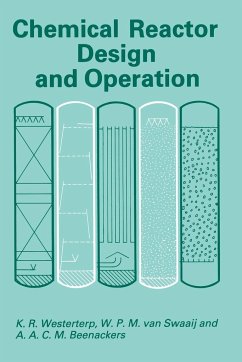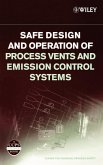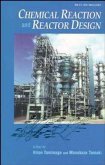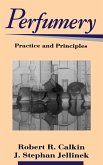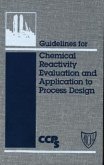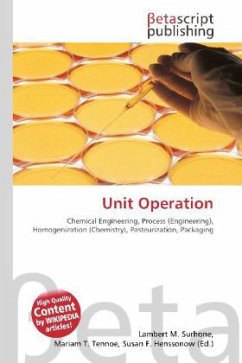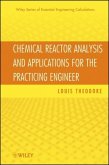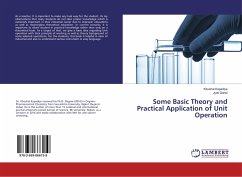- Broschiertes Buch
- Merkliste
- Auf die Merkliste
- Bewerten Bewerten
- Teilen
- Produkt teilen
- Produkterinnerung
- Produkterinnerung
Chemical Reactor Design and Operation K. R. Westerterp, W. P. M. van Swaaij and A. A. C. M. Beenackers Chemical Reaction Engineering Laboratories, Twente University of Technology, Enschede, The Netherlands This is a comprehensive handbook on the design and operation of chemical reactors which are vital elements in every manufacturing process. The book offers an introduction to the modern literature and covers in depth the relevant theory of chemical reactors. The theory is illustrated by numerous worked examples typical to chemical reaction engineering practice in research, development, design…mehr
Andere Kunden interessierten sich auch für
![Safe Design and Operation of Process Vents and Emission Control Systems Safe Design and Operation of Process Vents and Emission Control Systems]() Center for Chemical Process Safety (CCPS)Safe Design and Operation of Process Vents and Emission Control Systems184,99 €
Center for Chemical Process Safety (CCPS)Safe Design and Operation of Process Vents and Emission Control Systems184,99 €![Chemical Reaction and Reactor Design Chemical Reaction and Reactor Design]() Hiroo Tominaga / Masakazu Tamaki (Hgg.)Chemical Reaction and Reactor Design612,99 €
Hiroo Tominaga / Masakazu Tamaki (Hgg.)Chemical Reaction and Reactor Design612,99 €![Perfumery Perfumery]() Robert R CalkinPerfumery265,99 €
Robert R CalkinPerfumery265,99 €![Guidelines for Chemical Reactivity Evaluation and Application to Process Design Guidelines for Chemical Reactivity Evaluation and Application to Process Design]() Ccps (Center For Chemical Process Safety)Guidelines for Chemical Reactivity Evaluation and Application to Process Design175,99 €
Ccps (Center For Chemical Process Safety)Guidelines for Chemical Reactivity Evaluation and Application to Process Design175,99 €![Unit Operation Unit Operation]() Unit Operation23,99 €
Unit Operation23,99 €![Chemical Reactor Analysis and Applications for the Practicing Engineer Chemical Reactor Analysis and Applications for the Practicing Engineer]() Louis TheodoreChemical Reactor Analysis and Applications for the Practicing Engineer160,99 €
Louis TheodoreChemical Reactor Analysis and Applications for the Practicing Engineer160,99 €![Some Basic Theory and Practical Application of Unit Operation Some Basic Theory and Practical Application of Unit Operation]() Khushal KapadiyaSome Basic Theory and Practical Application of Unit Operation27,99 €
Khushal KapadiyaSome Basic Theory and Practical Application of Unit Operation27,99 €-
-
-
Chemical Reactor Design and Operation K. R. Westerterp, W. P. M. van Swaaij and A. A. C. M. Beenackers Chemical Reaction Engineering Laboratories, Twente University of Technology, Enschede, The Netherlands This is a comprehensive handbook on the design and operation of chemical reactors which are vital elements in every manufacturing process. The book offers an introduction to the modern literature and covers in depth the relevant theory of chemical reactors. The theory is illustrated by numerous worked examples typical to chemical reaction engineering practice in research, development, design and operation. The examples range from fine chemicals to large scale production and from water purification to metallurgical processes, commencing with simple homogenous model reactors and then moving to the complicated, multi-phase, heterogeneous reactors met with in reality. All the examples are based on the industrial experience of the authors. Much effort is dedicated to the behaviour of reactors in practice and to the capacity, yield and selectivity of the reactor. The book is thoroughly indexed and cross-referenced. This edition will be particularly useful to undergraduate and graduate students studying chemical reactors. Contents Fundamentals of chemical reactor calculations Model reactors: single reactions, isothermal single phase reactor calculations Model reactors: multiple reactions, isothermal single phase reactors Residence time distribution and mixing in continuous flow reactors Influence of micromixing on chemical reactions The role of the heat effect in model reactors Multi-phase reactors, single reactions Multi-phase reactors, multiple reactions Heat effects in multi-phase reactors The authors: The authors have accumulated a long experience both in fine chemicals and in the petrochemicals industry, in Europe as well as abroad. Currently they are jointly responsible for the research work in chemical reaction engineering and process development at Twente University. Several new reactor types and new processes have been developed at their institute and present research interests include gasification, fluidization and gas--liquid reactors, three-phase reactors, high-pressure technology in chemical reaction engineering, thermal behaviour of heterogeneous reactors and computer design and economic evaluation of reaction units and chemical plants.
Hinweis: Dieser Artikel kann nur an eine deutsche Lieferadresse ausgeliefert werden.
Hinweis: Dieser Artikel kann nur an eine deutsche Lieferadresse ausgeliefert werden.
Produktdetails
- Produktdetails
- Verlag: Wiley
- 3rd Revised edition
- Seitenzahl: 800
- Erscheinungstermin: 8. Januar 1991
- Englisch
- Abmessung: 229mm x 152mm x 42mm
- Gewicht: 1136g
- ISBN-13: 9780471917304
- ISBN-10: 0471917303
- Artikelnr.: 22384029
- Herstellerkennzeichnung
- Libri GmbH
- Europaallee 1
- 36244 Bad Hersfeld
- gpsr@libri.de
- Verlag: Wiley
- 3rd Revised edition
- Seitenzahl: 800
- Erscheinungstermin: 8. Januar 1991
- Englisch
- Abmessung: 229mm x 152mm x 42mm
- Gewicht: 1136g
- ISBN-13: 9780471917304
- ISBN-10: 0471917303
- Artikelnr.: 22384029
- Herstellerkennzeichnung
- Libri GmbH
- Europaallee 1
- 36244 Bad Hersfeld
- gpsr@libri.de
K. Roel Westerterp and W. P. M. Van Swaaij are the authors of Chemical Reactor Design and Operation, 2nd Edition, published by Wiley.
Preface to the First Edition Preface to the Second Edition Preface to the Student Edition List of Symbols Chapter I Fundamentals of chemical reactor calculations 1.1 Introduction 1.2 The material, energy and economic balance ?Material balance ?Energy balance ?Economic balance 1.3 Thermodynamic data: heat of reaction and chemical equilibrium ?Heat of reaction ?Chemical equilibrium 1.4 Conversion rate, chemical reaction rate and chemical reaction rate equations ?Influence of temperature on kinetics ?Influence of concentration on kinetics 1.5 The degree of conversion ?Relation between conversion and concentration expressions 1.6 Selectivity and yield ?Selectivity and yield in a reactor section with recycle of non-converted reactant 1.7 Classification of chemical reactors References Chapter II Model reactors: single reactions, isothermal single phase reactor calculations II.1 The well-mixed batch reactor II.2 The continuously operated ideal tubular reactor II.3 The continuously operated ideal tank reactor 11.4 The cascade of tank reactors II.5 The semi-continuous tank reactor II.6 The recycle reactor II.7 A comparison between the different model reactors ?Batch versus continuous operation ?Tubular reactor versus tank reactor II.8 Some examples of the influence of reactor design and operation on the economics of the process ?The use of one of the reactants in excess ?Recirculation of unconverted reactant ?Maximum production rate and optimum load with intermittent operation References Chapter III Model reactors: multiple reactions, isothermal single phase reactors III.1 Fundamental concepts ?Differential selectivity and selectivity ratio ?The reaction path III.2 Parallel reactions ?Parallel reactions with equal order rate equations ?Parallel reactions with differing reaction order rate equations ?A cascade of tank reactors III.3 The continuous cross flow reactor system III.4 Consecutive reactions ?First order consecutive reactions in a plug flow reactor ?First order consecutive reactions in a tank reactor ?General discussion III.5 Combination reactions ?Graphical methods ?Optimum yield in a cascade of tank reactors ?Algebraic methods III.6 Autocatalytic reactions ?Single biochemical reactions ?Multiple autocatalytic reactions References Chapter IV Residence time distribution and mixing in continuous flow reactors IV.1 The residence time distribution (RTD) ?The E and the F diagram ?The application of the RTD in practice IV.2 Experimental determination of the residence time distribution ?Input functions IV.3 Residence time distribution in a continuous plug flow and in a continuous ideally stirred tank reactor. IV.4 Models for intermediate mixing ?Model of a cascade of N equal ideally mixed tanks ?The axially dispersed plug flow model IV.5 Conversion in reactors with intermediate mixing IV.6 Some data on the longitudinal dispersion in continuous flow systems ?Flow through empty tubes ?Packed beds ?Fluidized beds ?Mixing in gas-liquid reactors References Chapter V Influence of micromixing on chemical reactions V.1 Nature of the micromixing phenomena ?Macro or gross overall mixing as characterized by the residence time distribution ?The state of aggregation of the reacting fluid ?The earliness of the mixing V.2 Boundaries to micromixing phenomena ?The model tubular and tank reactors ?Boundaries for micromixing for reactors with arbitrary RTDs V.3 Intermediate degree of micromixing in continuous stirred tank reactors ?Formal models ?Agglomeration models ?Model for micromixing via exchange of mass between agglomerates and their ?average? environment, the IEM model V.4 Experimental results on micromixing in stirred vessels V.5 Concluding remarks on micromixing References Chapter VI The role of the heat effect in model reactors VI.1 The energy balance and heat of reaction VI.2 The well-mixed batch reactor ?Batch versus semi-batch operation VI.3 The tubular reactor with external heat exchange ?Maximum temperature with exothermic reactions; para-metric sensitivity VI.4 The continuous tank reactor with heat exchange VI.5 Autothermal reactor operation ?The tank reactor ? An adiabatic tubular reactor with heat exchange between reactants and products ?A multi-tube reactor with internal heat exchange between the reaction mixture and the feed ?Determination of safe operating conditions VI.6 Maximum permissible reaction temperatures VI.7 The dynamic behaviour of model reactors ?The autothermal tank reactor ?Tubular reactor References Chapter VII Multiphase reactors, single reactions VII.1 The role of mass transfer VII.2 A qualitative discussion on mass transfer with homogeneous reaction ?Concentration distribution in the reaction phase VII.3 General material balance for mass transfer with reaction VII.4 Mass transfer without reaction ?Stagnant film model ?Penetration models of Higbie and Danckwerts VII.5 Mass transfer with homogeneous irreversible first order reaction ?Penetration models ?Stagnant film model ?General conclusion on mass transfer with homogeneous irreversible first order reaction ?Applications VII.6 Mass transfer with homogeneous irreversible reaction of complex kinetics VII.7 Mass transfer with homogeneous irreversible reaction of order (1.1) with Al ' 1 ?Slow reaction ?Fast reaction ?Instantaneous reaction ?General approximated solution VII.8 Mass transfer with irreversible homogeneous reaction of arbitrary kinetics with Al '1 VII.9 Mass transfer with irreversible reaction of order (1, 1) for a small Hinterland coefficient VII.10 Mass transfer with reversible homogeneous reactions VII.11 Reaction in a fluid-fluid system with simultaneous mass transfer to the non-reaction phase (desorption) VII.12 The influence of mass transfer on heterogeneous reactions ?Heterogeneous reaction at an external surface ?Reactions in porous solids VII.13 General criterion for absence of mass transport limitation VII.14 Heat effects in mass transfer with reaction ?Mass transfer with reaction in series ?Mass transfer with simultaneous reaction in a gas-liquid system ?Mass transfer with simultaneous reaction in a porous pellet VII.15 Model reactors for studying mass transfer with chemical reaction in heterogeneous systems ?Model reactors for gas-liquid reactions ?Model reactors for liquid-liquid reactions ?Model reactors for fluid-solid reactions. VII.16 Measurement techniques for mass transfer coefficients and specific contact areas in multi-phase reactors ?Measurement of the specific contact area a ?Measurement of the product kLa ?Measurement of the product kGa ?Measurement of mass transfer coefficients kL, kG VII.17 Numerical values of mass transfer coefficients and specific contact areas in multi-phase reactors ?Fluid-solid reactors ?Fluid-fluid (-solid) reactors References Chapter VIII Multi-phase reactors, multiple reactions VIII.1 Introduction VIII.2 Simultaneous mass transfer of two reactants A and A? with independent parallel reactions A
P and A?
X (Type I Selectivity) ?Mass transfer and reaction in series ?Mass transfer and reaction in parallel VIII.3 Mass transfer of one reactant (A) followed by two dependent parallel reactions A(+B)
P A(+B,B?)
X (Type II Selectivity) ?Mass transfer and reaction in series ?Mass transfer and reaction in parallel VIII.4 Simultaneous mass transfer of two reactants (A and A?) followed by dependent parallel reactions with a third reactant: A + B
P, A? + B
X ?Complete mass transfer limitation in non-reaction phase ?One reactant mass transfer limited in non-reaction phase ?One reaction instantaneous ?Both reactions instantaneous ?No diffusion limitation of reactant originally present in reaction phase ?More complex systems VIII.5 Simultaneous mass transfer of two reactants (A and A?) which react with each other VIII.6 Mass transfer with consecutive reactions A
P
X (Type III Selectivity) ?Mass transfer and reaction in series ?Mass transfer and reaction in parallel VIII.7 Mass transfer with mixed consecutive parallel reactions ?The system: A(1)
A(2); A(2) + B(2)
P(2); P(2) + B(2)
X(2) ?The system: A(1)
A(2); A(2) + B(2)
P(2); A(2) + P(2)
X(2) ?Complex systems References Chapter IX Heat effects in multi-phase reactors IX.1 Gas-liquid reactors ?General ?Column reactors ?Bubble column reactors ?Agitated gas-liquid reactors IX.2 Gas-solid reactors ?Single particle behaviour ?Catalytic gas-solid reactors ?The moving bed gas-solid reactor ?Thermal stability and dynamic behaviour of gas solid reactors IX.3 Gas-liquid-solid reactors References Chapter X The optimization of chemical reactors X.1 The object and means of optimization ?The objective function ?The optimization variables ?Relation between technical and economic optima X.2 Optimization by means of temperature ?The optimization of exothermic equilibrium reactions ?Temperature optimization with complex reaction systems X.3 Some mathematical methods of optimization ?Geometric programming ?The Lagrange multiplier technique ?Numerical search routines ?Dynamic programming Pontryagin?s maximum principle References Author index Subject Index
P and A?
X (Type I Selectivity) ?Mass transfer and reaction in series ?Mass transfer and reaction in parallel VIII.3 Mass transfer of one reactant (A) followed by two dependent parallel reactions A(+B)
P A(+B,B?)
X (Type II Selectivity) ?Mass transfer and reaction in series ?Mass transfer and reaction in parallel VIII.4 Simultaneous mass transfer of two reactants (A and A?) followed by dependent parallel reactions with a third reactant: A + B
P, A? + B
X ?Complete mass transfer limitation in non-reaction phase ?One reactant mass transfer limited in non-reaction phase ?One reaction instantaneous ?Both reactions instantaneous ?No diffusion limitation of reactant originally present in reaction phase ?More complex systems VIII.5 Simultaneous mass transfer of two reactants (A and A?) which react with each other VIII.6 Mass transfer with consecutive reactions A
P
X (Type III Selectivity) ?Mass transfer and reaction in series ?Mass transfer and reaction in parallel VIII.7 Mass transfer with mixed consecutive parallel reactions ?The system: A(1)
A(2); A(2) + B(2)
P(2); P(2) + B(2)
X(2) ?The system: A(1)
A(2); A(2) + B(2)
P(2); A(2) + P(2)
X(2) ?Complex systems References Chapter IX Heat effects in multi-phase reactors IX.1 Gas-liquid reactors ?General ?Column reactors ?Bubble column reactors ?Agitated gas-liquid reactors IX.2 Gas-solid reactors ?Single particle behaviour ?Catalytic gas-solid reactors ?The moving bed gas-solid reactor ?Thermal stability and dynamic behaviour of gas solid reactors IX.3 Gas-liquid-solid reactors References Chapter X The optimization of chemical reactors X.1 The object and means of optimization ?The objective function ?The optimization variables ?Relation between technical and economic optima X.2 Optimization by means of temperature ?The optimization of exothermic equilibrium reactions ?Temperature optimization with complex reaction systems X.3 Some mathematical methods of optimization ?Geometric programming ?The Lagrange multiplier technique ?Numerical search routines ?Dynamic programming Pontryagin?s maximum principle References Author index Subject Index
Preface to the First Edition Preface to the Second Edition Preface to the Student Edition List of Symbols Chapter I Fundamentals of chemical reactor calculations 1.1 Introduction 1.2 The material, energy and economic balance ?Material balance ?Energy balance ?Economic balance 1.3 Thermodynamic data: heat of reaction and chemical equilibrium ?Heat of reaction ?Chemical equilibrium 1.4 Conversion rate, chemical reaction rate and chemical reaction rate equations ?Influence of temperature on kinetics ?Influence of concentration on kinetics 1.5 The degree of conversion ?Relation between conversion and concentration expressions 1.6 Selectivity and yield ?Selectivity and yield in a reactor section with recycle of non-converted reactant 1.7 Classification of chemical reactors References Chapter II Model reactors: single reactions, isothermal single phase reactor calculations II.1 The well-mixed batch reactor II.2 The continuously operated ideal tubular reactor II.3 The continuously operated ideal tank reactor 11.4 The cascade of tank reactors II.5 The semi-continuous tank reactor II.6 The recycle reactor II.7 A comparison between the different model reactors ?Batch versus continuous operation ?Tubular reactor versus tank reactor II.8 Some examples of the influence of reactor design and operation on the economics of the process ?The use of one of the reactants in excess ?Recirculation of unconverted reactant ?Maximum production rate and optimum load with intermittent operation References Chapter III Model reactors: multiple reactions, isothermal single phase reactors III.1 Fundamental concepts ?Differential selectivity and selectivity ratio ?The reaction path III.2 Parallel reactions ?Parallel reactions with equal order rate equations ?Parallel reactions with differing reaction order rate equations ?A cascade of tank reactors III.3 The continuous cross flow reactor system III.4 Consecutive reactions ?First order consecutive reactions in a plug flow reactor ?First order consecutive reactions in a tank reactor ?General discussion III.5 Combination reactions ?Graphical methods ?Optimum yield in a cascade of tank reactors ?Algebraic methods III.6 Autocatalytic reactions ?Single biochemical reactions ?Multiple autocatalytic reactions References Chapter IV Residence time distribution and mixing in continuous flow reactors IV.1 The residence time distribution (RTD) ?The E and the F diagram ?The application of the RTD in practice IV.2 Experimental determination of the residence time distribution ?Input functions IV.3 Residence time distribution in a continuous plug flow and in a continuous ideally stirred tank reactor. IV.4 Models for intermediate mixing ?Model of a cascade of N equal ideally mixed tanks ?The axially dispersed plug flow model IV.5 Conversion in reactors with intermediate mixing IV.6 Some data on the longitudinal dispersion in continuous flow systems ?Flow through empty tubes ?Packed beds ?Fluidized beds ?Mixing in gas-liquid reactors References Chapter V Influence of micromixing on chemical reactions V.1 Nature of the micromixing phenomena ?Macro or gross overall mixing as characterized by the residence time distribution ?The state of aggregation of the reacting fluid ?The earliness of the mixing V.2 Boundaries to micromixing phenomena ?The model tubular and tank reactors ?Boundaries for micromixing for reactors with arbitrary RTDs V.3 Intermediate degree of micromixing in continuous stirred tank reactors ?Formal models ?Agglomeration models ?Model for micromixing via exchange of mass between agglomerates and their ?average? environment, the IEM model V.4 Experimental results on micromixing in stirred vessels V.5 Concluding remarks on micromixing References Chapter VI The role of the heat effect in model reactors VI.1 The energy balance and heat of reaction VI.2 The well-mixed batch reactor ?Batch versus semi-batch operation VI.3 The tubular reactor with external heat exchange ?Maximum temperature with exothermic reactions; para-metric sensitivity VI.4 The continuous tank reactor with heat exchange VI.5 Autothermal reactor operation ?The tank reactor ? An adiabatic tubular reactor with heat exchange between reactants and products ?A multi-tube reactor with internal heat exchange between the reaction mixture and the feed ?Determination of safe operating conditions VI.6 Maximum permissible reaction temperatures VI.7 The dynamic behaviour of model reactors ?The autothermal tank reactor ?Tubular reactor References Chapter VII Multiphase reactors, single reactions VII.1 The role of mass transfer VII.2 A qualitative discussion on mass transfer with homogeneous reaction ?Concentration distribution in the reaction phase VII.3 General material balance for mass transfer with reaction VII.4 Mass transfer without reaction ?Stagnant film model ?Penetration models of Higbie and Danckwerts VII.5 Mass transfer with homogeneous irreversible first order reaction ?Penetration models ?Stagnant film model ?General conclusion on mass transfer with homogeneous irreversible first order reaction ?Applications VII.6 Mass transfer with homogeneous irreversible reaction of complex kinetics VII.7 Mass transfer with homogeneous irreversible reaction of order (1.1) with Al ' 1 ?Slow reaction ?Fast reaction ?Instantaneous reaction ?General approximated solution VII.8 Mass transfer with irreversible homogeneous reaction of arbitrary kinetics with Al '1 VII.9 Mass transfer with irreversible reaction of order (1, 1) for a small Hinterland coefficient VII.10 Mass transfer with reversible homogeneous reactions VII.11 Reaction in a fluid-fluid system with simultaneous mass transfer to the non-reaction phase (desorption) VII.12 The influence of mass transfer on heterogeneous reactions ?Heterogeneous reaction at an external surface ?Reactions in porous solids VII.13 General criterion for absence of mass transport limitation VII.14 Heat effects in mass transfer with reaction ?Mass transfer with reaction in series ?Mass transfer with simultaneous reaction in a gas-liquid system ?Mass transfer with simultaneous reaction in a porous pellet VII.15 Model reactors for studying mass transfer with chemical reaction in heterogeneous systems ?Model reactors for gas-liquid reactions ?Model reactors for liquid-liquid reactions ?Model reactors for fluid-solid reactions. VII.16 Measurement techniques for mass transfer coefficients and specific contact areas in multi-phase reactors ?Measurement of the specific contact area a ?Measurement of the product kLa ?Measurement of the product kGa ?Measurement of mass transfer coefficients kL, kG VII.17 Numerical values of mass transfer coefficients and specific contact areas in multi-phase reactors ?Fluid-solid reactors ?Fluid-fluid (-solid) reactors References Chapter VIII Multi-phase reactors, multiple reactions VIII.1 Introduction VIII.2 Simultaneous mass transfer of two reactants A and A? with independent parallel reactions A
P and A?
X (Type I Selectivity) ?Mass transfer and reaction in series ?Mass transfer and reaction in parallel VIII.3 Mass transfer of one reactant (A) followed by two dependent parallel reactions A(+B)
P A(+B,B?)
X (Type II Selectivity) ?Mass transfer and reaction in series ?Mass transfer and reaction in parallel VIII.4 Simultaneous mass transfer of two reactants (A and A?) followed by dependent parallel reactions with a third reactant: A + B
P, A? + B
X ?Complete mass transfer limitation in non-reaction phase ?One reactant mass transfer limited in non-reaction phase ?One reaction instantaneous ?Both reactions instantaneous ?No diffusion limitation of reactant originally present in reaction phase ?More complex systems VIII.5 Simultaneous mass transfer of two reactants (A and A?) which react with each other VIII.6 Mass transfer with consecutive reactions A
P
X (Type III Selectivity) ?Mass transfer and reaction in series ?Mass transfer and reaction in parallel VIII.7 Mass transfer with mixed consecutive parallel reactions ?The system: A(1)
A(2); A(2) + B(2)
P(2); P(2) + B(2)
X(2) ?The system: A(1)
A(2); A(2) + B(2)
P(2); A(2) + P(2)
X(2) ?Complex systems References Chapter IX Heat effects in multi-phase reactors IX.1 Gas-liquid reactors ?General ?Column reactors ?Bubble column reactors ?Agitated gas-liquid reactors IX.2 Gas-solid reactors ?Single particle behaviour ?Catalytic gas-solid reactors ?The moving bed gas-solid reactor ?Thermal stability and dynamic behaviour of gas solid reactors IX.3 Gas-liquid-solid reactors References Chapter X The optimization of chemical reactors X.1 The object and means of optimization ?The objective function ?The optimization variables ?Relation between technical and economic optima X.2 Optimization by means of temperature ?The optimization of exothermic equilibrium reactions ?Temperature optimization with complex reaction systems X.3 Some mathematical methods of optimization ?Geometric programming ?The Lagrange multiplier technique ?Numerical search routines ?Dynamic programming Pontryagin?s maximum principle References Author index Subject Index
P and A?
X (Type I Selectivity) ?Mass transfer and reaction in series ?Mass transfer and reaction in parallel VIII.3 Mass transfer of one reactant (A) followed by two dependent parallel reactions A(+B)
P A(+B,B?)
X (Type II Selectivity) ?Mass transfer and reaction in series ?Mass transfer and reaction in parallel VIII.4 Simultaneous mass transfer of two reactants (A and A?) followed by dependent parallel reactions with a third reactant: A + B
P, A? + B
X ?Complete mass transfer limitation in non-reaction phase ?One reactant mass transfer limited in non-reaction phase ?One reaction instantaneous ?Both reactions instantaneous ?No diffusion limitation of reactant originally present in reaction phase ?More complex systems VIII.5 Simultaneous mass transfer of two reactants (A and A?) which react with each other VIII.6 Mass transfer with consecutive reactions A
P
X (Type III Selectivity) ?Mass transfer and reaction in series ?Mass transfer and reaction in parallel VIII.7 Mass transfer with mixed consecutive parallel reactions ?The system: A(1)
A(2); A(2) + B(2)
P(2); P(2) + B(2)
X(2) ?The system: A(1)
A(2); A(2) + B(2)
P(2); A(2) + P(2)
X(2) ?Complex systems References Chapter IX Heat effects in multi-phase reactors IX.1 Gas-liquid reactors ?General ?Column reactors ?Bubble column reactors ?Agitated gas-liquid reactors IX.2 Gas-solid reactors ?Single particle behaviour ?Catalytic gas-solid reactors ?The moving bed gas-solid reactor ?Thermal stability and dynamic behaviour of gas solid reactors IX.3 Gas-liquid-solid reactors References Chapter X The optimization of chemical reactors X.1 The object and means of optimization ?The objective function ?The optimization variables ?Relation between technical and economic optima X.2 Optimization by means of temperature ?The optimization of exothermic equilibrium reactions ?Temperature optimization with complex reaction systems X.3 Some mathematical methods of optimization ?Geometric programming ?The Lagrange multiplier technique ?Numerical search routines ?Dynamic programming Pontryagin?s maximum principle References Author index Subject Index

